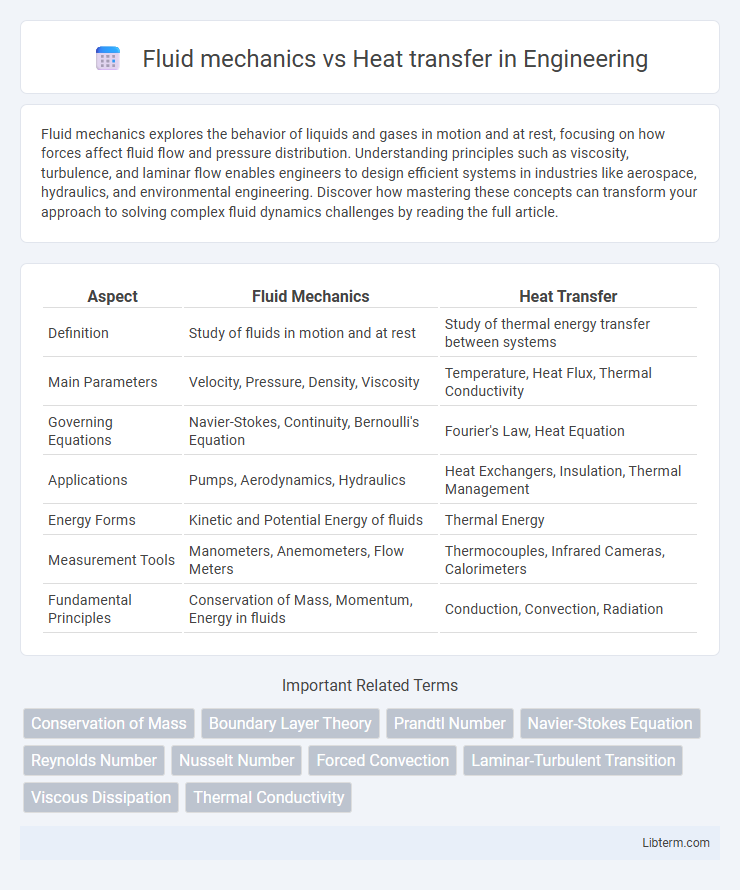Fluid mechanics explores the behavior of liquids and gases in motion and at rest, focusing on how forces affect fluid flow and pressure distribution. Understanding principles such as viscosity, turbulence, and laminar flow enables engineers to design efficient systems in industries like aerospace, hydraulics, and environmental engineering. Discover how mastering these concepts can transform your approach to solving complex fluid dynamics challenges by reading the full article.
Table of Comparison
| Aspect | Fluid Mechanics | Heat Transfer |
|---|---|---|
| Definition | Study of fluids in motion and at rest | Study of thermal energy transfer between systems |
| Main Parameters | Velocity, Pressure, Density, Viscosity | Temperature, Heat Flux, Thermal Conductivity |
| Governing Equations | Navier-Stokes, Continuity, Bernoulli's Equation | Fourier's Law, Heat Equation |
| Applications | Pumps, Aerodynamics, Hydraulics | Heat Exchangers, Insulation, Thermal Management |
| Energy Forms | Kinetic and Potential Energy of fluids | Thermal Energy |
| Measurement Tools | Manometers, Anemometers, Flow Meters | Thermocouples, Infrared Cameras, Calorimeters |
| Fundamental Principles | Conservation of Mass, Momentum, Energy in fluids | Conduction, Convection, Radiation |
Introduction to Fluid Mechanics and Heat Transfer
Fluid mechanics studies the behavior of fluids in motion and at rest, analyzing properties such as pressure, velocity, density, and viscosity to understand fluid flow dynamics in various engineering applications. Heat transfer explores the mechanisms of thermal energy exchange via conduction, convection, and radiation, essential for designing efficient thermal management systems in industries like HVAC, power generation, and electronics cooling. Both disciplines overlap in convective heat transfer, where fluid flow phenomena directly impact thermal energy transport and temperature distribution.
Fundamental Concepts in Fluid Mechanics
Fluid mechanics explores the behavior and motion of fluids, emphasizing principles such as fluid statics, dynamics, viscosity, and boundary layer theory. Critical concepts include the conservation of mass (continuity equation), momentum (Navier-Stokes equations), and energy within fluid flow systems. Understanding pressure distribution, flow regimes (laminar and turbulent), and fluid properties lays the groundwork for analyzing heat transfer processes that depend on convective fluid motion.
Basic Principles of Heat Transfer
Heat transfer involves the study of energy transfer due to temperature differences through conduction, convection, and radiation, governed by Fourier's law, Newton's law of cooling, and Stefan-Boltzmann law respectively. Fluid mechanics plays a crucial role in convective heat transfer by analyzing fluid flow behavior, velocity profiles, and turbulence, which directly influence convective heat transfer coefficients. Understanding the basic principles of heat transfer requires integrating thermodynamics and fluid dynamics to optimize thermal system designs and enhance energy efficiency.
Key Differences Between Fluid Mechanics and Heat Transfer
Fluid mechanics studies the behavior and movement of fluids, emphasizing velocity, pressure, and forces within liquids and gases. Heat transfer focuses on the mechanisms of thermal energy movement, including conduction, convection, and radiation, and how temperature gradients drive this process. The key difference lies in fluid mechanics analyzing fluid flow properties, while heat transfer concentrates on energy exchange and temperature changes in materials.
Mathematical Models in Fluid Mechanics
Mathematical models in fluid mechanics primarily involve the Navier-Stokes equations, which describe the motion of viscous fluid substances and are fundamental for predicting fluid flow behavior. These equations are complemented by the continuity equation for mass conservation and the energy equation when considering heat transfer within moving fluids. Computational Fluid Dynamics (CFD) techniques utilize these models to simulate complex fluid flow and heat transfer interactions in engineering and environmental applications.
Governing Equations in Heat Transfer
The governing equations in heat transfer primarily include the heat conduction equation derived from Fourier's law, expressed as \(\frac{\partial T}{\partial t} = \alpha \nabla^2 T\), where \(T\) is temperature, \(t\) is time, and \(\alpha\) is thermal diffusivity. These equations describe the distribution and flow of thermal energy within solids or fluids, contrasting with fluid mechanics equations like the Navier-Stokes equations that govern fluid flow dynamics. Understanding the coupling between heat transfer equations and fluid momentum balances is essential for accurately modeling convective heat transfer phenomena.
Applications of Fluid Mechanics in Engineering
Fluid mechanics plays a crucial role in engineering applications such as aerodynamic design, hydrodynamics, and HVAC systems, where understanding fluid behavior enhances performance and efficiency. It is essential for predicting flow patterns in pipelines, designing pumps and turbines, and optimizing propulsion in aerospace engineering. This knowledge enables engineers to manage fluid forces and energy transfer, improving system reliability and safety across various industries.
Applications of Heat Transfer in Industry
Heat transfer plays a crucial role in industries such as power generation, chemical processing, and electronics cooling by enabling efficient thermal management and energy conservation. Techniques like conduction, convection, and radiation are applied in heat exchangers, furnaces, and refrigeration systems to optimize production processes and maintain equipment longevity. Understanding heat transfer principles allows engineers to design safer, more efficient industrial systems that enhance productivity and reduce operational costs.
Interconnection Between Fluid Flow and Heat Exchange
Fluid mechanics and heat transfer are intrinsically linked through convective heat transfer, where fluid flow profoundly influences thermal energy distribution. The velocity, turbulence, and viscosity of fluids affect the convective heat transfer coefficient, thereby determining the efficiency of heat exchange in systems such as heat exchangers and cooling channels. Understanding the interdependence between fluid dynamics and thermal gradients is crucial for optimizing industrial processes, HVAC design, and energy systems performance.
Future Trends in Fluid Mechanics and Heat Transfer
Future trends in fluid mechanics emphasize advanced computational fluid dynamics (CFD) enhanced by machine learning algorithms to optimize aerodynamic designs and energy efficiency. In heat transfer, innovations in nanofluids and phase-change materials are driving improved thermal management systems for electronics and renewable energy applications. Integration of multiphysics simulations is increasingly crucial for accurately modeling coupled fluid-thermal systems in aerospace and biomedical engineering.
Fluid mechanics Infographic

 libterm.com
libterm.com